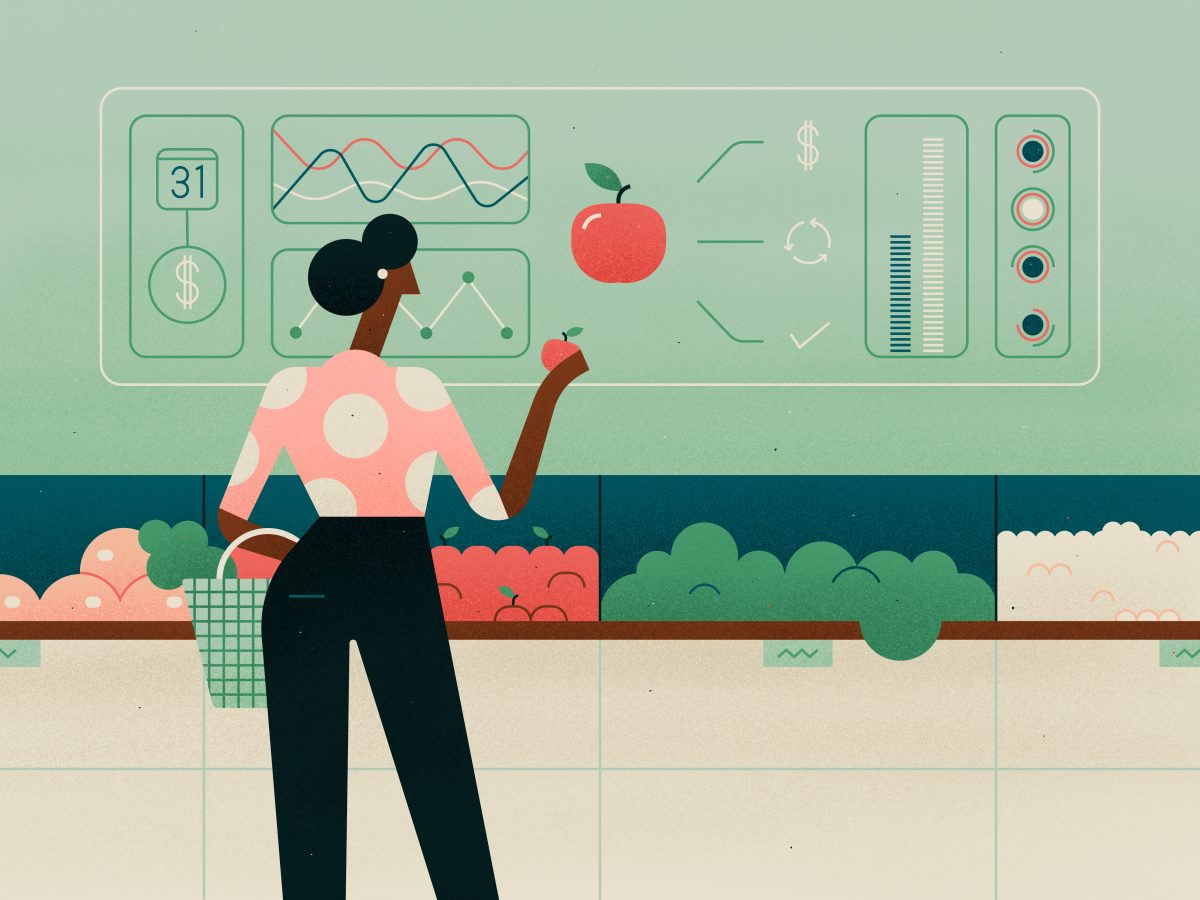
You’re in the poultry section of your supermarket, hoping to get some chicken for tonight’s dinner. You notice a pack expiring sooner than the rest at a reduced price. Would you choose that chicken? Not everyone will – some will want to prepare their chicken in several days’ time. But if you’re having chicken tonight, you’ll likely choose the cheaper chicken and feel good about saving money.
When multiplied over countless supermarket buying decisions each day, common-sense consumer choices could become a game-changer if prices better kept pace with expiration dates. But for food retailers, adjusting prices to account for demand and expiration dates is labor-intensive.
Food waste is a super-sized problem. The United Nations says we waste 1.3 billion tonnes of food each year, valued at 2.6 trillion US dollars. That’s a third of all food produced for human consumption. Food waste accounts for around six percent of greenhouse gas emissions – three times the emissions from aviation.
Wasteless, a tech start-up founded in 2017, hopes its cutting-edge AI-based technology for grocery retail dynamic pricing could radically reduce the waste when supermarkets must dispose of expired, unsold goods.

Kaspersky retail cybersecurity
Kaspersky retail cybersecurity
POS, workstation and all IT infrastructure cybersecurity solution for retailers.
Discounts without discount stickers
Wasteless is already in supermarket chains like Spain’s Dia, Italy’s Iper and Belgium’s Intermarche Jurbise. In 2020, they ranked 19th in the FoodTech 500 list of international “agrifoodtech” start-ups and scale-ups based on size, digital footprint and sustainability practices.
Combining their algorithm with an electronic shelf label (ESL) system, stores can show a price that reduces as the item’s expiration date nears. ESLs change in real-time as the algorithm sets and resets markdowns. When short-dated products sell out, the ESL returns to the original price.
“Food waste costs supermarkets a tremendous amount of money. It doesn’t make sense to keep working this way from a business, sustainability or consumer perspective,” says David Kat, Wasteless’s Senior Vice President of Business Development.
If we’re shopping and we see pasta salad expiring tomorrow and one dated next week, we invariably choose the longer expiration date – unless we’re rewarded for conscious consumer behavior.
David Kat, Senior Vice President of Business Development, Wasteless
That’s what the supermarkets have in mind too. Wasteless quotes former Iper IT director Gian Maria Gentile in a case study: “Iper implemented Wasteless technology to stimulate consumers to make a more sustainable choice, reducing food waste and optimizing product availability.”
AI reinforcement learning sets optimal discounts
Wasteless’s dynamic pricing engine uses “reinforcement learning.” It takes into account how consumers trade off expiration dates against discounts, which changes depending on how many items are on a shelf. Wasteless can set an optimal discounting policy for each retailer.
The algorithm also considers when the next shipment arrives, how many units remain at which prices, and potential substitute product availability to understand how customers choose. The logic helps avoid under- and over-pricing, leading to shortages (and reduced profits) and surpluses.
With all those factors, it’s a job for artificial intelligence (AI,) insists Kat, which is what sets Wasteless apart from the status quo. Discount sticker-slapping and making sudden bargain bins before a store closes is costly, he says. “Slapping stickers is operationally difficult, expensive and time-consuming, but also degrades the product. You’re basically saying, this product doesn’t have real value,” Kat explains. With a system like Wasteless, “Discounts are applied when needed, not just on the last day or hours before closing. If the AI sees it’s needed, the discount can kick in three or four days before expiration, so the price is right at the right moment.”
The food waste reduction journey is complex
Human psychology may be the simpler part to navigate – customers can save money, do good and feel good. Where Wasteless has been implemented, consumers understand the system and respond to the discounted price, cutting food waste.
Retailers should have the same reasons as consumers to want to cut costs while making a positive impact on the world, but Kat says the business psychology is more complex. Wasteless is a “hard sell” to some retailers.
Firstly, it’s a “difficult problem to solve for” in companies using little data science, he says. It also means working with all layers of a business, especially IT departments, as Wasteless uses the retailer’s private cloud and cybersecurity protocols, although only price, not customer data, is stored.
Finance, marketing and operations must be able to see what’s happening in a pricing system, yet frustratingly, Kat notes, these business units usually have no responsibility for food waste.
“Food waste is seen as the cost of doing business. No one loses their bonus because of food waste. And that’s a problem because most food waste happens in high-income countries, in retail and consumer environments.”
Regardless of the environmental impact, there’s a clear business case for solving food waste. When Wasteless entered Italian supermarket chain Iper, expired food waste fell 39 percent and revenue rose 10 percent. Spain’s chain Dia cut waste by one-third while boosting revenue 6 percent.
No-brainer for savvy retailers
The idea of “optimal markdowns” is gaining traction with more savvy retailers, Kat believes. He thinks smaller chains tend to be more entrepreneurial and open-minded than larger counterparts, that may be more hesitant to introduce new components to complex IT systems.
Kat continues, “It’s easy to keep doing business as usual. Retailers are well-organized, logistical machines, but dynamic pricing isn’t changing the machine.” If it doesn’t work, it’s just “deleting one line of code and you’re running your business as before.” But with the potential for chains to raise every store’s bottom line by around 120,000 US dollars, simply by selling what they’ve previously thrown away, Kat is adamant the return on investment makes it a no-brainer.
“We need food waste reduction targets, but they’re ambitious. You can’t achieve them with traditional methods. Retailers must approach from different angles,” he says.
Cutting waste in hospitality and retail
The travel sector was first to understand the value of dynamic pricing. Consumers are used to seeing the cost of flights and hotel rooms rise as their planned travel date nears.
Dynamic pricing has helped European hostel and hotel chain A&O keep bookings high over the past year despite the pandemic. They used another start-up, Pace Revenue, to keep ‘pace’ with changing customer demand.
While hotel rooms in larger cities usually cost more than those in smaller cities, since COVID-19, when lockdowns are lifted, holidaymakers have sought to avoid the crowds. Rooms priced cheaply soared in value as last-minute bookings poured in, driving prices up and selling all the rooms at a higher margin.
The potential to cut food waste and related costs exists in hospitality too. A&O’s Chief Marketing Officer Philip Winter gives the example of applying dynamic pricing to breakfast, which operates for five hours with few punters at 6 am and a rush at 9 am. A lower price for an early breakfast, he says, could help clear the buffet and reduce uneaten items.
Dynamic pricing is also seeing success in general retail, with UK marketing agency Digital Ethos introducing it over the past year to e-commerce clients in fashion, drinks and home interiors.
Fashion retail has a faster stock turnaround than most retail, with many stores changing their entire stock at least twice a year with seasons and trends. With dynamic pricing, new season jeans could fluctuate in price depending on supply and demand, even rising in price as stock diminishes and the last pair becomes a prized commodity. It’s the reverse of Wasteless’s food model, but the outcomes are the same: No human pricing needed, increased revenue and reduced waste.
Consumers are familiar with sales and discount stickers as a markdown mechanism. But we know they embrace new pricing models when the benefits are clear. Will more retailers see they can use this tech to sell more and reduce waste? It depends if they’ve set their sights on ‘business as usual,’ or the future.




